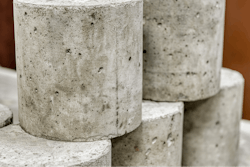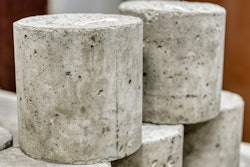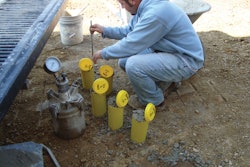
The typical concrete break test happens within a month, right on the 28-day mark. According to section 19.2.1.3 of ACI 318-19, compressive strength should be based on this test unless otherwise specified. Earlier breaks can be done to determine early strength gain – typically specified for a 3- and/or 7-day break – but early break data are not commonly used for acceptance purposes.  AC Business Media | Photographed by Jonathan Kozlowski
AC Business Media | Photographed by Jonathan Kozlowski
The engineers at the UW-Madison Civil and Environmental Engineering department have been the stewards of an extensive collection of concrete cylinder experiment. With a snap, crack, and a bang - this experiment has finally ended and nowhere near the ACI 28-day recommendation. Of course, this was not a test for strength acceptance but a project to find data on what happens to concrete over long period of time. Concrete Contractor was fortunate enough to be able to attend a few of the breaks on Friday, July 21.
With no outside forces save for the environment, would the concrete deteriorate? Would the hydration reaction continue?
The project originally began by faculty member Morton O. Withey. Over time, three extensive series of 6- by 12-in. concrete cylinders were cast and some were left outside in the Madison, Wisconsin weather to live. Cylinders cast in 1910 were originally created for a 10-year study, yet some from this initial batch sat for 100 years until 2010. Cylinders for a 50-year study were added in 1937 and concluded in 1987. The concrete cylinders broken in July 2023 were cast in 1923.
According to online calculations - depending on the exact date the casting took place – this comes to roughly 36,500 days. This concrete is older than the Hoover Dam.
When the announcement was made that the project will be ending, the Wisconsin State Journal reported in January 2023.
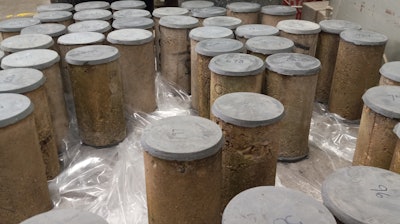 AC Business Media | Photographed by Jonathan Kozlowski
AC Business Media | Photographed by Jonathan Kozlowski
Three different mixes consisting of two water-cement ratio, four hydraulic cements and three different aggregate sources were used. All locally sourced. Thousands of cylinders were cast in total specially for the project with about 150 remaining to be tested in 2023. None of the cylinders for the experiment were to represent the concrete of a particular construction project or concrete placement.
The project was overseen by a handful of professors during the 113 years. Most recently, professor Steven Cramer, who was kind enough to return to the lab during his retirement.
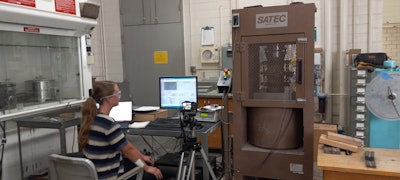 AC Business Media | Photographed by Jonathan Kozlowski
AC Business Media | Photographed by Jonathan Kozlowski
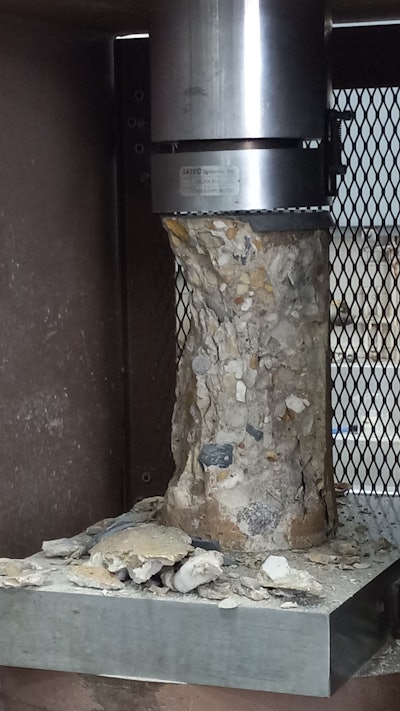 AC Business Media | Photographed by Jonathan Kozlowski
AC Business Media | Photographed by Jonathan Kozlowski
Interestingly, results of 2010’s breaks showed that the concrete cylinders which had exposure to water (submerged in water) gained strength while those kept dry inside storage lost strength. (Storage did not simulate environmental conditions.)
Compared to the data from the 1910 cylinders, they are seeing an increase in strength despite the cold Wisconsin winters and humid summers.
The 2023 tests were conducted by Ella Thomas, research assistant. Each cylinder will be put through three presses, two of which stopping the pressure at 105,000 lbs. with the third continuing until break. Equipment was overseen by Jacob Zeuske, lab manager.
On the third trail, if you listened carefully enough, one could hear soft cracking as the pounds increased – a crackle similar to the morning’s cereal bowl.
The cylinder was uneventful. It was the opposite of watching concrete cure. It’s all timing. Slow but then quick. As the cylinder held strong, eyes gaze to the computer to watch the readout and compressive strength graph climb.
105,000 lbs.
150,000 lbs.
200,000 lbs.
Then, a loud pop and often energetic enough to throw small pieces of concrete through the safety gate.
The first cylinder of the day breaks at 238,620 lbs. with an 8,370 compressive strength. Another later in the day breaks at over 305,000 lbs. of pressure.
The break tests are planned to continue throughout summer 2023, culminating roughly mid-August. Cramer will be analyzing data and results are projected to be available later this year.
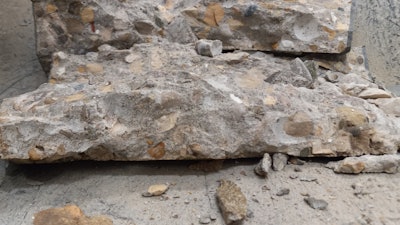 AC Business Media | Photographed by Jonathan Kozlowski
AC Business Media | Photographed by Jonathan Kozlowski





